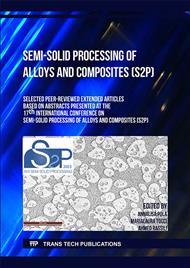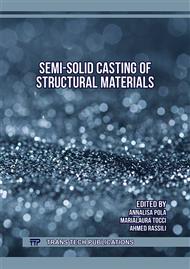p.75
p.83
p.91
p.97
p.107
p.115
p.121
p.127
p.135
Rheological Behaviour of Secondary AlSi7Mg Alloy for Semi-Solid Processing
Abstract:
Semisolid castings are usually produced using primary Al alloys to ensure significant mechanical performances. However, the need to increase the use of secondary alloys is becoming more and more urgent to reduce the carbon footprint of the manufacturing process. In fact, it is well known that the production of primary alloys is far more demanding in terms of energy and emissions than the recycling route. To extend the use of secondary alloys to semisolid processing, it is necessary to thoroughly understand their properties and how they can influence a material with peculiar properties as the semisolid one. Besides microstructural and mechanical features, the rheological behaviour also plays a major role when dealing with processing metals in the semisolid state. Therefore, in the present study, a rheological characterization of secondary AlSi7Mg commercial alloy was carried out and compared to that of the conventional primary alloy. In details, a different content of Fe, Cu and Mn was considered, as these impurities easily form primary intermetallic particles, which can remain dispersed in the liquid matrix of the semisolid metal. The aim of this work is to understand if this can affect the rheological properties of the considered semisolid alloy. Flow curves and yield stresses were obtained from the experimental results to compare the behaviour of the different alloys.
Info:
Periodical:
Pages:
107-113
Citation:
Online since:
August 2023
Authors:
Keywords:
Price:
Сopyright:
© 2023 Trans Tech Publications Ltd. All Rights Reserved
Share:
Citation:



